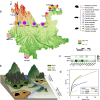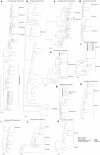Host taxonomy and environment shapes insectivore viromes and viral spillover risks in Southwestern China
- PMID: 40380277
- PMCID: PMC12083107
- DOI: 10.1186/s40168-025-02115-9
Host taxonomy and environment shapes insectivore viromes and viral spillover risks in Southwestern China
Abstract
Background: Zoonotic viruses originating from small mammals pose significant challenges to public health on a global scale. Insectivores, serving as natural reservoirs for a diverse array of zoonotic viruses, are known to carry a multitude of viral species. However, compared to the extensive research conducted on rodents (Rodentia) and bats (Chiroptera), the role of insectivores in harboring and transmitting unknown pathogens remains underexplored, which may lead to a severe underestimation of their contributions and impact to global public health.
Results: This study employed a meta-transcriptomic approach to profile the viromes of 214 individual insectivores, encompassing 13 species from the families Soricidae, Erinaceidae, and Talpidae, collected across 12 counties in Yunnan Province, a recognized zoonotic hotspot. Based on virus reads, the analysis identified 42 viral families associated with vertebrates, highlighting significant virome diversity and host-specific viral tropisms among shrews, hedgehogs, and moles, along with notable geographic and environmental specificity of the viruses. Shrews exhibited greater viral richness and abundance compared to hedgehogs and moles, with variations influenced predominantly by host taxonomy, altitude, and geographic location. A total of 114 RNA-dependent RNA polymerase sequences were obtained, leading to the identification of 68 viruses, including 57 novel species. Instances of host jumping were observed in 11 viruses, with potential pathogenic viruses related to Mojiang paramyxovirus and members of the Hantaviridae family. Cross-species transmission was predominantly observed in viruses carried by shrews, while moles may play a pivotal role in facilitating viral transmission among insectivores.
Conclusions: This study enhances the understanding of the high diversity of mammalian viruses among insectivores in a relatively confined region and underscores the associations between virome composition and related zoonotic risks, providing a foundation for proactive measures to prevent and control the spillover of emerging zoonotic pathogens and potential future outbreaks. Video Abstract.
Keywords: Emerging infectious diseases; Environment; Insectivore; Viral evolution; Virome.
© 2025. The Author(s).
Conflict of interest statement
Declarations. Ethics approval and consent to participate: This study was approved by the Animal Subjects Research Review Boards at the Yunnan Institute of Endemic Diseases Control and Prevention (2014-010), in accordance with China’s medical research regulations and the Regulation of the People’s Republic of China for the Implementation of the Protection of Terrestrial Wildlife. Consent for publication: Not applicable. Competing interests: The authors declare no competing interests.
Figures





Similar articles
-
Virome landscape of wild rodents and shrews in Central China.Microbiome. 2025 Mar 3;13(1):63. doi: 10.1186/s40168-025-02059-0. Microbiome. 2025. PMID: 40033356 Free PMC article.
-
Virome characterization of field-collected rodents in suburban city.NPJ Biofilms Microbiomes. 2025 Jun 11;11(1):103. doi: 10.1038/s41522-025-00740-8. NPJ Biofilms Microbiomes. 2025. PMID: 40500267 Free PMC article.
-
Unveiling bat-borne viruses: a comprehensive classification and analysis of virome evolution.Microbiome. 2024 Nov 14;12(1):235. doi: 10.1186/s40168-024-01955-1. Microbiome. 2024. PMID: 39543683 Free PMC article.
-
Common Themes in Zoonotic Spillover and Disease Emergence: Lessons Learned from Bat- and Rodent-Borne RNA Viruses.Viruses. 2021 Jul 31;13(8):1509. doi: 10.3390/v13081509. Viruses. 2021. PMID: 34452374 Free PMC article. Review.
-
[Bats and Viruses: complex relationships].Bull Soc Pathol Exot. 2015 Oct;108(4):272-89. doi: 10.1007/s13149-015-0448-z. Epub 2015 Sep 1. Bull Soc Pathol Exot. 2015. PMID: 26330152 Free PMC article. Review.
References
-
- Lam TTY, Jia N, Zhang YW, Shum MHH, Jiang JF, Zhu HC, Tong YG, Shi YX, Ni XB, Liao YS, Li WJ, Jiang BG, Wei W, Yuan TT, Zheng K, Cui XM, Li J, Pei GQ, Qiang X, Cheung WYM, Li LF, Sun FF, Qin S, Huang JC, Leung GM, Holmes EC, Hu YL, Guan Y, Cao WC. Identifying SARS-CoV-2-related coronaviruses in Malayan pangolins. Nature. 2020;583(7815):282–5. - PubMed
-
- Temmam S, Vongphayloth K, Baquero E, Munier S, Bonomi M, Regnault B, Douangboubpha B, Karami Y, Chrétien D, Sanamxay D, Xayaphet V, Paphaphanh P, Lacoste V, Somlor S, Lakeomany K, Phommavanh N, Pérot P, Dehan O, Amara F, Donati F, Bigot T, Nilges M, Rey FA, Van Der Werf S, Brey PT, Eloit M. Bat coronaviruses related to SARS-CoV-2 and infectious for human cells. Nature. 2022;604(7905):330–6. - PubMed
-
- Symonds MRE. Phylogeny and life histories of the ‘Insectivora’: controversies and consequences. Biol Rev. 2005;80(1):93–128. - PubMed
MeSH terms
Grants and funding
- 2024YFC2607500/The State Key Research Development Program of China
- 2024YFC2607500/The State Key Research Development Program of China
- 2024YFC2607500/The State Key Research Development Program of China
- 2024YFC2607500/The State Key Research Development Program of China
- 2024YFC2607500/The State Key Research Development Program of China
- 2024YFC2607500/The State Key Research Development Program of China
- 2024YFC2607500/The State Key Research Development Program of China
- 2024YFC2607500/The State Key Research Development Program of China
- 2024YFC2607500/The State Key Research Development Program of China
- 2024YFC2607500/The State Key Research Development Program of China
- 2024YFC2607500/The State Key Research Development Program of China
- 2024YFC2607500/The State Key Research Development Program of China
- 2024YFC2607500/The State Key Research Development Program of China
- 2024YFC2607500/The State Key Research Development Program of China
- 2024YFC2607500/The State Key Research Development Program of China
- 2024YFC2607500/The State Key Research Development Program of China
LinkOut - more resources
Full Text Sources

